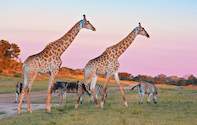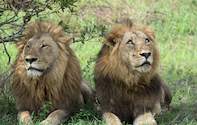
Fences and Animal Diseases
In the 1960's the management of the Kruger National Park decided to erect a fence between the park and the neighbouring private reserves, to prevent diseases from infecting the wildlife of the park. This prompted the Sabi Sands management to fence the whole park in to prevent the wildlife from moving out into the neighbouring areas. Constant monitoring of the wildlife was essential to protect the diversity of the area.
In the 1990's the fence between the Kruger Park and the Sabi Sand Private Game Reserve was pulled down after an agreement between the conservation bodies of both parks was forged, allowing wildlife to roam freely again across both regions.
Conservation and Wildlife Management
The lodges in the Sabi Sand Game Reserve are involved in environmental management and conservation programmes that ensure the well-being of all the wildlife in Sabi Sands. Projects that are part of the environmental programmes include alien plant control, micro catchment management to combat erosion, monitoring of Sabi Sands animals and habitat densities, anti-poaching activities and fire control management.
The conservation bodies in the Sabi Sands work closely with the officials of the Kruger National Park to ensure that the wildlife of the region is managed in accordance with conservation principles.
The Big Five and Other Creatures

The Sabi Sands is renowned for the Big Five (Lion, Leopard, Elephant, Buffalo and Rhino). In fact it was in the Sabi Sands where the hunting concept that is the Big Five was rekindled as a photo safari term. So successful was this term marketed in the photo safari arena that today it is taken as the apex of wildlife viewing whilst on safari in Africa.
Also read more about The Sabie Sands Secret Seven
But it is not only the Big Five that can be seen in the Sabi Sands - just a glance at the species lists show the incredible diversity of Sabi Sands wildlife. The lists contain 145+ mammal species, 500+ bird species, 30+ amphibian species, 110+ reptile species and 45+ fish species.
To add to these impressive Sabi Sands animal species lists are the 330+ tree species that can be found on the reserve. All these species are indigenous to the area and because of limited farming practices in the past the environment is virtually as it was when humans first set foot in the region.
Some of the mammals to be seen in the Sabi Sands include
- Aardvark
- African Wild Cat
- Chacma Baboon
- Bushbuck
- Buffalo
- Lesser Bushbaby
- Caracal
- Cheetah
- Civet
- Elephant
- Giraffe
- Large-spotted Genet
- Honey Badger
- Spotted Hyena
- Hippo
- Impala
- Black-backed Jackal
- Side-striped Jackal
- Kudu
- Leopard
- Lion
- Vervet Monkey
- Nyala
- Pangolin
- Cape Porcupine
- White Rhinoceros
- Serval
- Steenbok
- Tsessebe
- Warthog
- Waterbuck
- Blue Wildebeest
- Wild Dog
- Burchell's Zebra

 The Sabi Sands Private Game Reserve is home to seven very secretive and mysterious creatures that survive by being extremely enigmatic about...
The Sabi Sands Private Game Reserve is home to seven very secretive and mysterious creatures that survive by being extremely enigmatic about... With our Classic Kruger Safaris in the Sabi Sand Game Reserve, you can expect comfortable accommodation, ample 4x4 game viewing, hearty meal...
With our Classic Kruger Safaris in the Sabi Sand Game Reserve, you can expect comfortable accommodation, ample 4x4 game viewing, hearty meal...